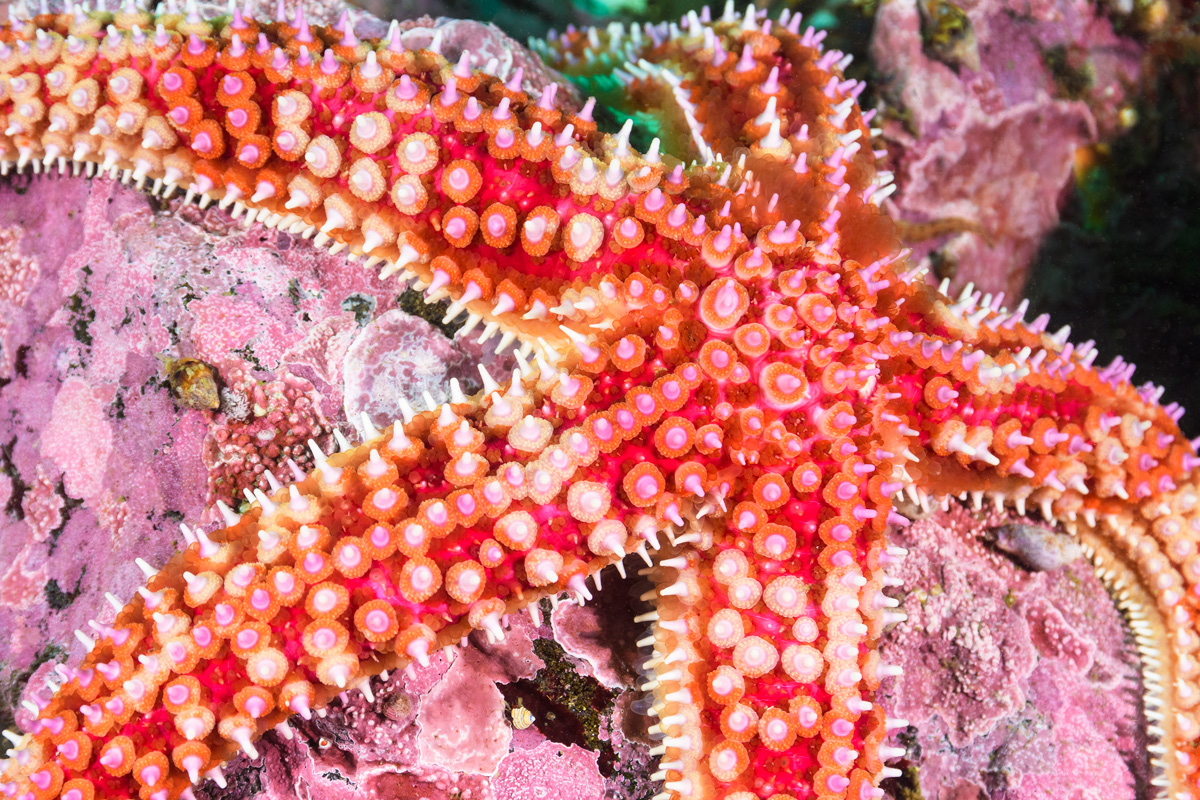Island Rock serves as habitat for marine life such as the rainbow sea star (Orthasterias koehleri)
How to Scuba Dive Island Rock in Port Orford, Oregon
Brandon Cole
It’s so colorful and there’s so much invertebrate life— and fish life too.” There are a few reasons why Diana Hollingshead, a 2018 inductee into the Women Divers Hall of Fame and Oregon volunteer coordinator for Reef Check Foundation, is so passionate about diving in her backyard.
“We get some strong offshore currents that help feed the invertebrate life,” says Hollingshead of Port Orford, a gateway to Oregon’s coast where she frequently dives. She welcomes visiting divers to Eugene Skin Divers Supply, which she co-owns with her husband, Michael. Strong currents and unpredictable weather pose some challenges for accessing prime dive sites. However, southern Oregon’s rugged nooks and crannies are not to be overlooked.
Less than half an hour by boat from Port Orford, a pair of jagged rocks emerges from the Pacific. The larger of the two formations looks like a sperm whale to viewers gazing out from Highway 101, at least to Dave Lacey, owner of South Coast Tours. Island Rock, or, as Lacey calls it, “Whale Island,” sits within the Oregon Islands Wilderness, part of the Oregon Islands National Wildlife Refuge. A diverse range of marine life inhabits the site’s complex saltwater systems: Everything from intertwined kelp to tiny zooplankton to a tufted puffin colony seeking shelter from the wind and water that have shaped Oregon’s coastline for millennia. And divers may share the water with California sea lions, abalone, fish, snails, transient sea otters and crabs—especially big king crabs.
Related Reading: Exploring the Underwater Splendors of Oregon
China rockfish (sebastes nebulosus)
Brandon Cole
“We get all kinds of crazy weather here: glassy perfect days, super heavy winds and swells.” This variability, Lacey says, is not for beginners. Oregon’s dive tourism community holds a common understanding that this is “not the easiest place to dive. It’s almost never fl at. It’s not like Florida or the Caribbean in terms of consistent safe diving.”
Eugene Skin Divers Supply communicates all the variables to divers who seek guidance. “We try to advise people as to the local conditions, to make sure that they’re safe,” Hollingshead explains. “I would not [recommend diving] offshore in Oregon unless they have advanced certification and cold-water experience, preferably in a drysuit.” Eugene Skin Divers Supply can also provide a dive guide.
Marine photographer Brandon Cole patiently waited for a trip to Island Rock with Lacey. “When it looked like the weather was finally going to cooperate, my wife and I drove 600 miles from our home in eastern Washington to jump on South Coast Tour’s sweet inflatable, Black Pearl, for the opportunity to explore this impressive chunk of basalt below the waves. Among the invert-covered boulders in 40 to 80 feet we encountered numerous lingcod, kelp greenlings, and a half dozen different species of rockfish. To top it off, we found a mated pair of wolf eels at the end of the dive!”
Related Reading: Diving for a Cause: How to Support Marine Protected Areas
Red rock crab (Cancer productus) and more among colorful anemones
Brandon Cole
Both Lacey and Hollingshead are active participants in community-driven sustainability initiatives that preserve this special environment. “The South Coast has 75 percent of all the rocky reef habitat and kelp forest in the whole state,” Lacey says. The area benefits from surveys conducted by organizations like Reef Check Foundation. Threats found in nearby waters include “an explosion of urchins that are decimating the kelp,” and sea star wasting disease, Lacey explains.
“Reef Check utilizes volunteer citizen science divers to monitor Oregon’s kelp forests to contribute to the preservation and protection of these vital ecosystems,” says Dan Abbott, Kelp Forest Program director at Reef Check Foundation.
To support surveys, Lacey takes divers out on his rigid-hull inflatable boat during the April to October dive season, and Hollingshead recruits prospective volunteers throughout the year.
Bull kelp (Nereocystis luetkeana) is considered a foundation species that acts as an ecological building block and vital food source in areas like Island Rock.
Cassidy Vincent
Site Spotlight
Bull kelp (Nereocystis luetkeana) is considered a foundation species that acts as an ecological building block and vital food source in areas like Island Rock. It can grow 10 inches or more per day and reach over 100 feet in length. Many organisms start off their lives among the kelp and rely on it as they grow.
“The beauty and diversity of Oregon’s kelp forests are a wonder to behold, but they’re also incredibly important for the health of our oceans and the planet as a whole,” says Abbott.
“Everything is intertwined,” Hollingshead explains. “People overlook it because they don’t see it. They don’t understand what an important resource it is, how it acts as a resource for juvenile everything—fish, juvenile crabs.”
Need to Know
Conditions
“A good day is when you get decent viz—10-plus feet—you’re not fighting 6-foot swells, and you’re not fighting the current,” Hollingshead says. Much of the southern coastal waters hover between 45 and 55 degrees for most of the year. Lacey says the stretch of coast from Port Orford south to Brookings, Oregon, “is 5 degrees warmer on average compared to the rest of the state!” It’s hard to predict conditions on a given day, so be prepared to change the plan pending any fog, swells or visibility shifts after arriving at the site.
When to Visit
Spring to early fall.
How to Dive It
Book a tour through a local operator such as South Coast Tours.
What to Wear
Drysuit.
Local PADI Dive Shops
Eugene Skin Divers Supply eugeneskindivers.com

When you subscribe to the blog, we will send you an e-mail when there are new updates on the site so you wouldn't miss them.
